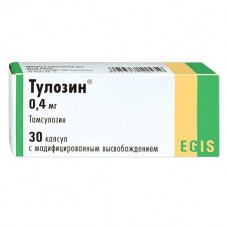Expiration date: 09/2026
Structure and Composition:
Capsules modified release. One capsule contains Tamsulosin hydrochloride 0.4 mg
Other ingredients: calcium stearate MCC copolymer of ethyl acrylate and methacrylic acid (in the form of an aqueous dispersion of 30% solution), Tween 80 (Polysorbate 80), triethyl citrate talc
the composition of the capsule shell: Valium Valium yellow gelatin titanium dioxide
in blister 10 pcs. In the paper cartons 1 or 3 blisters.
Description pharmaceutical form:
Capsules modified release: solid, gelatinous, self-closing, with a transparent base green (color code - 13009) and opaque cover green (color code - 17026). Pellets - almost white, odorless or almost odorless.
Pharmacokinetics:
Suction. After oral tamsulosin is rapidly and almost completely absorbed from the gastrointestinal tract. The bioavailability of the drug - about 100%.
After a single oral administration of tamsulosin in plasma Cmax achieved within 6 hours.
Immediately after ingestion decreases the absorption of tamsulosin. The uniformity of the suction increases when the patient takes medication every day after the same meal.
In the equilibrium state (after 5 days course doses) Cmax values ??of tamsulosin in plasma by 60-70% higher than the Cmax after a single dose.
Distribution. Binding to plasma proteins - 99%. Tamsulosin has a slight volume of distribution (about 0.2 l / kg).
Metabolism. Tamsulosin is practically not subjected to the effect of the first passage slowly biotransformed in the liver with the formation of pharmacologically active metabolites that retain high selectivity to & alphalA-adrenoceptor. None of the metabolites is more active than the starting material. Most of the active substance is present in the blood in an unmodified form.
When liver failure dose refinement is required.
Withdrawal. Tamsulosin and its metabolites are primarily excreted by the kidneys, and about 9% of the dose is excreted unchanged.
T1 / 2 at a single dose of tamsulosin - 10 hours after multiple dose - 13 hours, the final half-life - 22 hours.
In violation of renal function, the dose does not require elaborate preparation.
Description of the pharmacological actions:
Tamsulosin selectively and competitively blocks postsynaptic & alpha1A-adrenoceptors located in the smooth muscle of the prostate, bladder neck and prostatic urethra and adrenoceptors & alpha1D-, preferably located in the body of the bladder. This leads to a reduction in smooth muscle tone of the prostate, bladder neck and prostatic urethra and detrusor improve function. This reduces the symptoms of obstruction and irritation associated with benign prostatic hyperplasia. Typically, the therapeutic effect develops after 2 weeks after starting the drug, although in some patients the decrease of symptoms is observed after the first dose. The ability to influence the tamsulosin & alpha1A-adrenoceptors 20 times greater than its ability to interact with & alpha1B-adrenoceptors are located in vascular smooth muscle. Due to such a high selectivity of the drug does not cause any clinically significant reduction in systemic blood pressure both in hypertensive patients and in patients with normal baseline BP.
Indications:
Treatment of functional symptoms of benign prostatic hyperplasia.
Contraindications:
Hypersensitivity to tamsulosin hydrochloride or any other component of the formulation.
Carefully:
- chronic renal failure (creatinine Cl decrease below 10 ml / min)
- hypotension (in Vol. h. orthostatic)
- severe hepatic impairment.
Side effect:
The most common side effects (1-10%) - dizziness, drowsiness or insomnia.
Rare (0.1-1%) - headache, decreased visual acuity, rhinitis, nausea, vomiting, diarrhea or constipation, retrograde ejaculation, fatigue, decreased libido, pain in the back.
Extremely Rare (0.01-0.1%) - orthostatic hypotension, tachycardia, palpitation, chest pain, syncope, hypersensitivity reactions (rash, pruritus, urticaria, angioedema).
Single (<0.01%) - priapism.
Drug Interactions:
The simultaneous use of cimetidine increases the rate of tamsulosin in plasma reduces Furosemide tamsulosin in plasma. However, in both cases the levels are within the therapeutically active levels, and do not modify the dosage.
Diclofenac and indirect anticoagulants increase the number of clearance rate of tamsulosin.
Concomitant use of tamsulosin with other alpha1-blockers & and other drugs to lower blood pressure, can lead to a marked strengthening of the hypotensive effect.
There were no interactions with the concomitant use of tamsulosin with atenolol, enalapril, nifedipine or theophylline.
The concentration of tamsulosin in plasma did not change in the presence of diazepam, trichloromethiazide, amitriptyline, diclofenac, glibenclamide, simvastatin or warfarin.
Tamsulosin also did not change the concentration of diazepam, propranolol, trichlormethiazide and chlormadinone.
Dosage and administration:
Inside, after a meal.
400 mg (1 capsule.) Per day.
Capsules are taken after the first meal, drinking plenty of water. The capsule should not crush and chew.
Overdose:
Cases of acute overdose have not been described.
Symptoms: theoretically may cause acute hypotension.
Treatment: The patient should be put to restore blood pressure and normalize heart rate. Spend kardiotropnyh therapy. It is necessary to monitor renal function and to apply the general supportive therapy. If the symptoms persist, you should enter obemozameschayuschie solutions or vasoconstrictor drugs. To prevent further absorption of tamsulosin may gastric lavage, the appointment of activated charcoal or osmotic laxative. Dialysis is ineffective since tamsulosin binds strongly to plasma proteins.
Special instructions:
Tamsulosin should be used with caution in patients with a predisposition to orthostatic hypotension, because as in the case of receiving other alpha1-adrenoceptor antagonists in some patients during the course of treatment may decrease blood pressure, which can sometimes lead to fainting. At the first signs of orthostatic hypotension (dizziness or weakness), the patient should sit or lay until symptoms disappear.
Before starting drug therapy, the patient must be examined in order to exclude the presence of other diseases that can cause similar symptoms as BPH. Before you start treatment and regularly during treatment, digital rectal examination should be performed and, if necessary, determination of prostate-specific antigen (PSA).
In patients with severe renal impairment (Cl creatinine less than 10 mL / min), the drug should be used with caution, because This group of patients has not been studied.
Effects on ability to drive vehicles and management mechanisms. During the period of treatment must be careful when driving and occupation of other potentially hazardous activities that require high concentration and psychomotor speed reactions.


